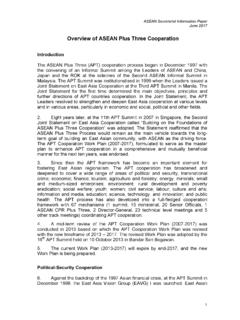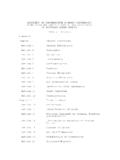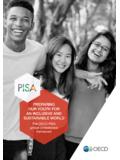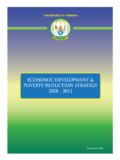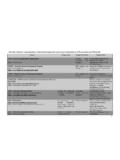Transcription of Reviewed strategic framework - Food and …
1 C 2013/7 March 2013 FoodandAgricultureOrganizationoftheUnite dNationsOrganizaci ndelasNacionesUnidasparala организацияОНацийAlimentaci nylaAgriculturaOrganisation Nations Uniespourl'alimentationet l'agriculture des бъединенныхПродовольственная иcельскохозяйственная This document can be accessed using the Quick Response Code on this page; a FAO initiative to minimize its environmental impact and promote greener communications. Other documents can be consulted at E CONFERENCE Thirty-eighth Session Rome, 15 - 22 June 2013 Reviewed strategic framework Table of Contents Pages Director-General's Foreword .. 2 Executive Summary .. 3 A. The strategic Thinking Process .. 4 B. FAO Vision and Global Goals .. 6 C. Main Global Trends and Challenges .. 6 Macroeconomic, social and political trends.
2 6 Major global trends with direct implications on the areas of FAO s mandate .. 6 Main Global Challenges .. 13 D. FAO s Attributes, Core Functions and Comparative Advantages .. 16 The changing development cooperation environment and implications for FAO .. 17 FAO s basic organizational attributes .. 17 Core Functions .. 18 Comparative advantages in relation to the selected challenges .. 19 E. strategic Objectives .. 20 strategic Objective 1: Contribute to the eradication of hunger, food insecurity and malnutrition .. 21 strategic Objective 2: Increase and improve provision of goods and services from agriculture, forestry and fisheries in a sustainable manner .. 22 strategic Objective 3: Reduce rural poverty .. 23 strategic Objective 4: Enable more inclusive and efficient agricultural and food systems at local, national and international levels.
3 24 strategic Objective 5: Increase the resilience of livelihoods to threats and crises .. 25 Objective on technical quality, knowledge and services .. 25 Cross-cutting themes: Gender and Governance .. 26 C 2013/7 2 Director-General's Foreword We all share a common vision of a world free from hunger and malnutrition, where food security and agriculture contribute to improving the living standards of all, especially the poorest, in an economically, socially and environmentally sustainable manner. We may be a long way from realizing this vision fully, but it is a vision that is achievable, and one in which FAO has a key role to play. Therefore, on taking office in January 2012, I launched a wide and inclusive initiative to modernize and transform the Organization. The aim is to improve the delivery and impact of FAO s programmes by effective translation of our normative work into country-level impact, and of our global knowledge products into tangible change in policy and practice.
4 One of the fundamental pillars of the transformational change process is the review of the strategic framework 2010-19, which is mandated by the Organization s programme and budget cycle every four years. For this purpose, I launched a strategic Thinking Process, which provided the conceptual and analytical framework for reorienting the strategic direction of FAO by reviewing its strategic framework . It involved the wide participation of FAO staff, advice from external experts, and substantive inputs from Members Nations through the various FAO governing bodies and informal consultations. The first key outcome of this process is the realization by Members of the need to commit the Organization to the eradication of hunger, by elevation of FAO s first Global Goal from reducing to eliminating hunger, as recommended by the Council.
5 The second key outcome is the identification of a set of five new cross-cutting strategic Objectives, closely aligned with the most relevant and urgent development problems faced by member countries and the development community. The five strategic Objectives, as well as a sixth objective focused on technical knowledge, quality and services, will guide the work of the Organization in contributing to the eradication of hunger, increasing sustainable production, eliminating rural poverty, enabling more inclusive and efficient food and agricultural systems, and increasing the resilience of livelihoods. The third key outcome of the process is a refined set of seven core functions as means of action for the Organization through normative work and standard setting instruments, data and information, policy dialogue, capacity development, uptake of knowledge and technologies, facilitating partnerships, and advocacy and communications.
6 The strategic framework defines a new way of working for FAO and will require considerable changes in the way we operate: to be more focused in our priorities; to work more as a corporate team; and to have greater impact through partnerships. As such, it is a compact with the FAO membership to work together to achieve our common vision of a world free from hunger and malnutrition. Jos Graziano da Silva Director-General 3 C 2013/7 Executive Summary FAO has Reviewed its strategic framework 2010-19 as part of the established planning, programme and budget system. The review and preparation was guided by the strategic Thinking Process introduced by the Director-General upon taking office in January 2012 to determine the future strategic direction of the Organization. This document presents the Reviewed strategic framework , in particular FAO s Vision, Global Goals and strategic Objectives, for endorsement by the Conference.
7 The Reviewed strategic framework provides the overarching strategic direction for the Organization. Starting from FAO s Vision and Global Goals, the strategic Thinking Process, through a series of iterative, analytical and consultative steps, identified: (i) overarching, global, political, and socio-economic trends envisaged to frame agricultural development over the medium term; (ii) main challenges, derived from these trends, expected to be faced by member countries and development actors in food and agriculture in the coming years; and (iii) FAO s basic attributes, core functions and comparative advantages mapped against the main challenges. The concepts of comparative advantages and core functions have been revisited by means of a critical analysis centred on two elements: the evolving development cooperation environment globally, and FAO s basic organizational attributes.
8 As a result of the analysis, a revised set of seven core functions has been defined, being the critical means of action to be employed by FAO to achieve results. The review of the strategic framework has benefited from consultations with FAO s governing bodies during 2012: the Regional Conferences, Technical Committees, Programme and Finance Committees and Council. While FAO s Vision and Global Goals were approved by the Conference in 2009, the Council recommended an amendment to Global Goal 1 that elevates it from reducing to eliminating hunger. FAO s vision is A world free from hunger and malnutrition where food and agriculture contribute to improving the living standards of all, especially the poorest, in an economically, socially and environmentally sustainable manner . The three Global Goals of Members are: 1) eradication of hunger, food insecurity and malnutrition, progressively ensuring a world in which people at all times have sufficient safe and nutritious food that meets their dietary needs and food preferences for an active and healthy life; 2) elimination of poverty and the driving forward of economic and social progress for all, with increased food production, enhanced rural development and sustainable livelihoods; and 3) sustainable management and utilization of natural resources, including land, water, air, climate and genetic resources for the benefit of present and future generations.
9 Five new strategic Objectives have been extrapolated and represent the main areas of work on which FAO will concentrate its efforts in striving to achieve its Vision and Global Goals: 1. Contribute to the eradication of hunger, food insecurity and malnutrition 2. Increase and improve provision of goods and services from agriculture, forestry and fisheries in a sustainable manner 3. Reduce rural poverty 4. Enable more inclusive and efficient agricultural and food systems at local, national and international levels 5. Increase the resilience of livelihoods to threats and crises An objective on technical quality, knowledge and services, and two cross-cutting themes on gender and governance, are integral to the achievement of the strategic Objectives. The Reviewed strategic framework has guided the formulation of the Medium Term Plan 2014-17 and Programme of Work and Budget Suggested action by the Conference The Conference is invited to endorse the Reviewed strategic framework , in particular FAO s Vision, Global Goals and strategic Objectives.
10 1 C 2013/3 C 2013/7 4 A. The strategic Thinking Process 1. At its 36th session in November 2009, the Conference established2 a renewed programme and budget approach for FAO consistent with actions arising from the Immediate Plan of Action on priorities and programmes for the Organization. This new approach introduced revised planning documentation for the Organization, including a strategic framework , prepared for a period of ten to fifteen years and Reviewed every four years, a Medium Term Plan (MTP) covering a period of four years, and a two-year Programme of Work and Budget (PWB). In addition, the new arrangements envisaged the Regional Conferences, Technical Committees and the Programme and Finance Committees advising the Council on programme and budget matters, including priority areas of work for the Organization.











